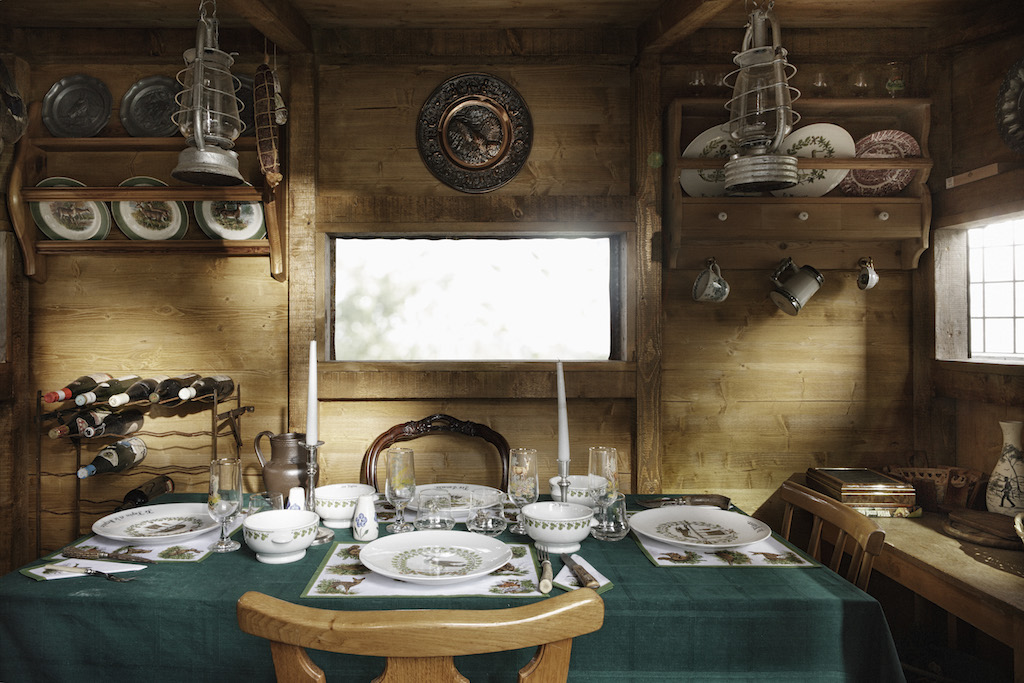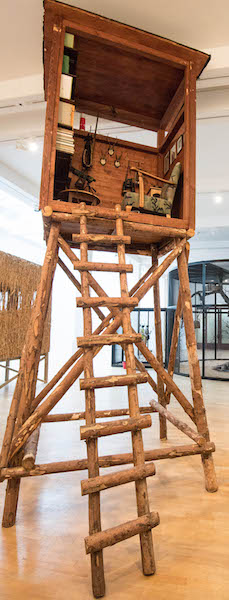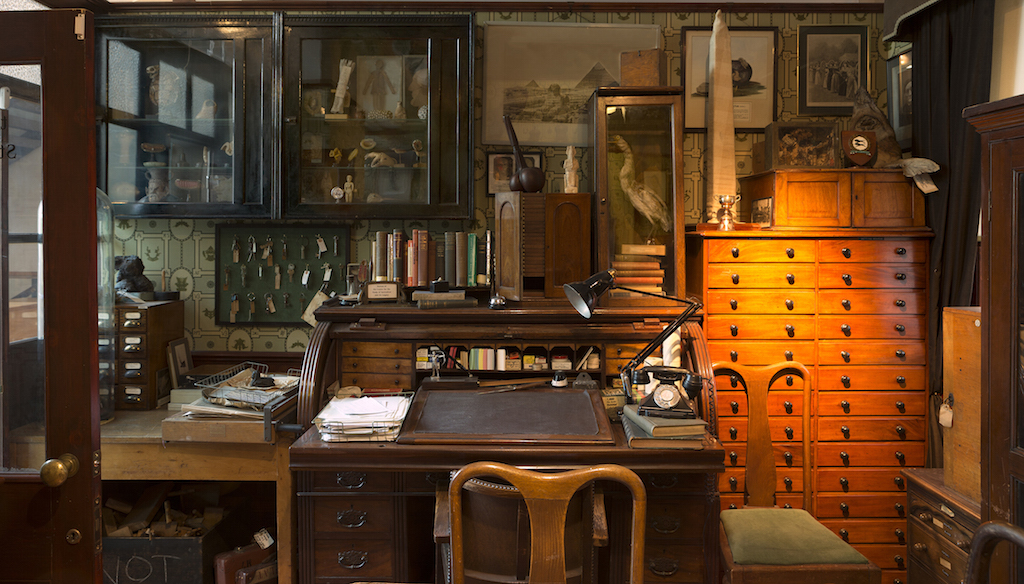On entering the gallery, you are greeted by the cheeping of birds. A flock of zebra finches flies around a circular cage and comes to rest on the branches of the apple tree “planted” in Mark Dion’s latest installation (main picture), before taking off on another circuit. Despite being confined inside an aviary, they seem happy enough; how, though, does one tell? Most of us living in cities know precious little about birds or any of the other species sharing the planet with us – although, of course, we try to learn something.
Heaped around the foot of the tree and arranged on branches and log shelves are numerous tomes full of learned observations about birds, in particular, and the natural world, in general. The finches use the books as perches, which reminds me of a remark made by the American painter Barnet Newman: “Art criticism is to artists what ornithology is to the birds.” In other words, totally irrelevant.
You can enter the cage, which is decked out with pictures of various ornithologists and some of the gear used by the more intrepid ones such as binoculars, a pith helmet, an axe, saws, a camping-gas stove. With clean sawdust on the floor, the installation is like a cosy encampment, a place where Pooh Bear might have felt at home.  A decoy duck serves to remind us of our less benign relationship with wildlife and surrounding the aviary are hides (or blinds) of the type used for hunting as well as observing game. Each is decked out to suggest a different aspect of the sport. The Glutton, 2008 (pictured above) is an unprepossessing shack made of corrugated iron; inside, though, is a dining table laid for the sumptuous feast that will follow the shoot, while a bucket of bones indicates the many banquets previously held here.
A decoy duck serves to remind us of our less benign relationship with wildlife and surrounding the aviary are hides (or blinds) of the type used for hunting as well as observing game. Each is decked out to suggest a different aspect of the sport. The Glutton, 2008 (pictured above) is an unprepossessing shack made of corrugated iron; inside, though, is a dining table laid for the sumptuous feast that will follow the shoot, while a bucket of bones indicates the many banquets previously held here.
In The Dandy-Rococo Hunting Blind a chandelier hangs above a vintage sofa, Turkey carpet and numerous hunting trophies. Flasks of brandy are further reminders that hunting was once the “sport of kings”. (Pictured below right: Hunting Blind (The Librarian) 2008). Six hunting standards hang nearby on the gallery wall; resembling medieval pennants; heraldic images of dead game recall the historical importance of the chase for Europe’s erstwhile royalty and aristocracy.

With its period furniture and collection of curios, The Naturalist’s Study, 2018 resembles the domain of a Victorian naturalist. There’s a coral tree hung with shark’s teeth, a unicorn’s horn (actually a narwhal’s) and various fossils (actually plaster fakes). The message is complicated, though, by Dion’s wallpaper which bears images of extinct species such as the dodo and woolly mammoth, and photographs he took in natural history museums of stuffed polar bears, a reminder that they also face possible extinction. But the pictures lack the chilling dispassion of Hiroshi Sugimoto’s famous photographs of museum dioramas, which record the enormous care taken to mimic various habitats and wildlife which, in reality, we destroy so thoughtlessly.
A further warning that all is not well on God’s earth comes with images of dead trees drawn in tar and a pigeon skeleton dipped in the same substance; but they fail to compete with the photographs one sees on the news of virgin forest decimated by loggers or dead seabirds coated in oil. If they are an attempt to address the devastating impact of exploitation and pollution, they are far too muted.
Instead of travelling to foreign lands like a Victorian explorer collecting exotic specimens, Dion was invited in 2002 to trawl through the collection of the Manchester Museum. The Bureau of the Centre for the Study of Surrealism and Its Legacy (pictured below) brings together items dug out from dusty corners and forgotten drawers. Unusual juxtapositions of things like stuffed birds, Egyptian figurines and wax models are intended to trigger a sense of the uncanny associated with surrealism, but the installation is visible only through a glass partition so there is no way of judging its efficacy. This inaccessibility makes it feel like a mausoleum honouring the intrepid collectors who donated their many treasures to our museums.  Tate Thames Dig, 1999 has a much clearer focus. Teams of volunteers spent a week digging in the mud exposed at low tide at Millbank and Bankside. Their findings were cleaned, sorted and collated and a splendid display case made to accommodate them. Fragments of porcelain and pottery, glass bottles, clay pipes, chains, rusty nails, cutlery, teeth and bones, shoe leather and, more recently, mobile phones, electric cable and plastics including combs, bottle tops and credit cards are placed in drawers or stashed away in boxes. Beautifully arranged, the stuff we make, use and throw away becomes a time capsule, a poetic record of our presence in this place.
Tate Thames Dig, 1999 has a much clearer focus. Teams of volunteers spent a week digging in the mud exposed at low tide at Millbank and Bankside. Their findings were cleaned, sorted and collated and a splendid display case made to accommodate them. Fragments of porcelain and pottery, glass bottles, clay pipes, chains, rusty nails, cutlery, teeth and bones, shoe leather and, more recently, mobile phones, electric cable and plastics including combs, bottle tops and credit cards are placed in drawers or stashed away in boxes. Beautifully arranged, the stuff we make, use and throw away becomes a time capsule, a poetic record of our presence in this place.
But recent events, such as a president in the White House who seems hell-bent on speeding up the destruction of the planet and the growing realisation that plastic waste is choking the oceans make Mark Dion’s work seem much too softly spoken. The contentious issue of our disregard for or exploitation of other species can’t be glossed over by whimsical evocations of times past, when wildlife was plentiful and the planet was not in dire straits.
- Mark Dion: Theatre of the Natural World at the Whitechapel Gallery to 13 May
- Read more visual art reviews on theartsdesk








![SEX MONEY RACE RELIGION [2016] by Gilbert and George. Installation shot of Gilbert & George 21ST CENTURY PICTURES Hayward Gallery](/sites/default/files/styles/thumbnail_125_x_125_/public/mastimages/Gilbert%20%26%20George_%2021ST%20CENTURY%20PICTURES.%20SEX%20MONEY%20RACE%20RELIGION%20%5B2016%5D.%20Photo_%20Mark%20Blower.%20Courtesy%20of%20the%20Gilbert%20%26%20George%20and%20the%20Hayward%20Gallery._0.jpg?itok=3oW-Y84i)





Add comment